MGMT 1102: Corporate Social Responsibility in the Modern Era
VerifiedAdded on 2023/06/12
|8
|1756
|355
Essay
AI Summary
This essay provides a detailed analysis of Corporate Social Responsibility (CSR) within the framework of Wayne Visser's 'Age of Responsibility.' It explores the key drivers that compel companies to prioritize sustainability, including environmental degradation, increased transparency, and the strategic advantages of sustainable practices. The essay discusses the principles of scalability, creativity, glocality, responsiveness, and circularity, illustrating them with real-world examples such as Vodafone's M-PESA and GSK's patent pool. It also addresses the trade-offs between responsiveness and scalability, using Walmart as a case study. Furthermore, the essay examines the concept of glocalization in CSR, emphasizing the need for companies to adapt to local conditions while upholding universal principles, suggesting reformulation of cleaning products for a household cleaning services company in Canada as a practical example. This assignment solution is available on Desklib, a platform offering a wealth of study resources and solved assignments for students.
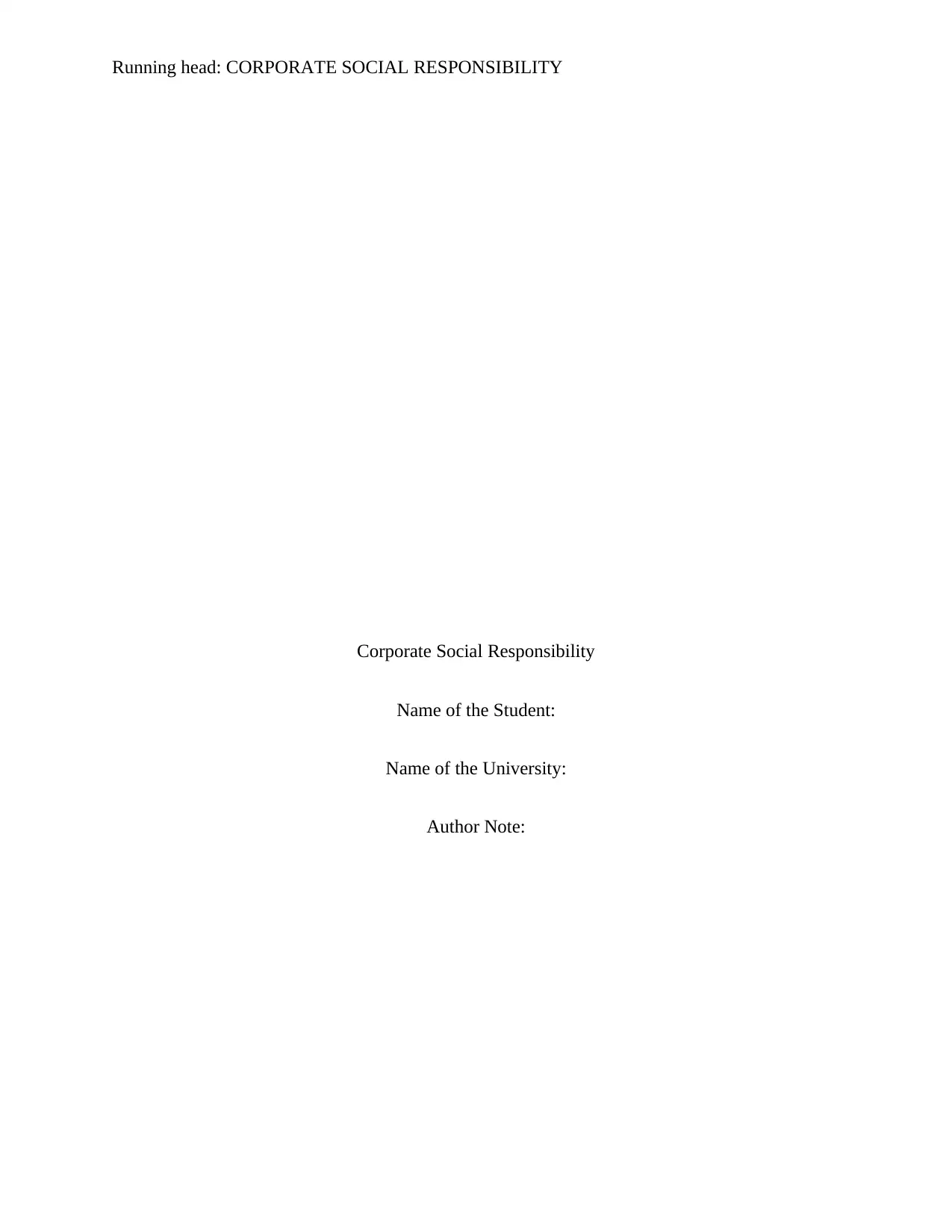
Running head: CORPORATE SOCIAL RESPONSIBILITY
Corporate Social Responsibility
Name of the Student:
Name of the University:
Author Note:
Corporate Social Responsibility
Name of the Student:
Name of the University:
Author Note:
Paraphrase This Document
Need a fresh take? Get an instant paraphrase of this document with our AI Paraphraser
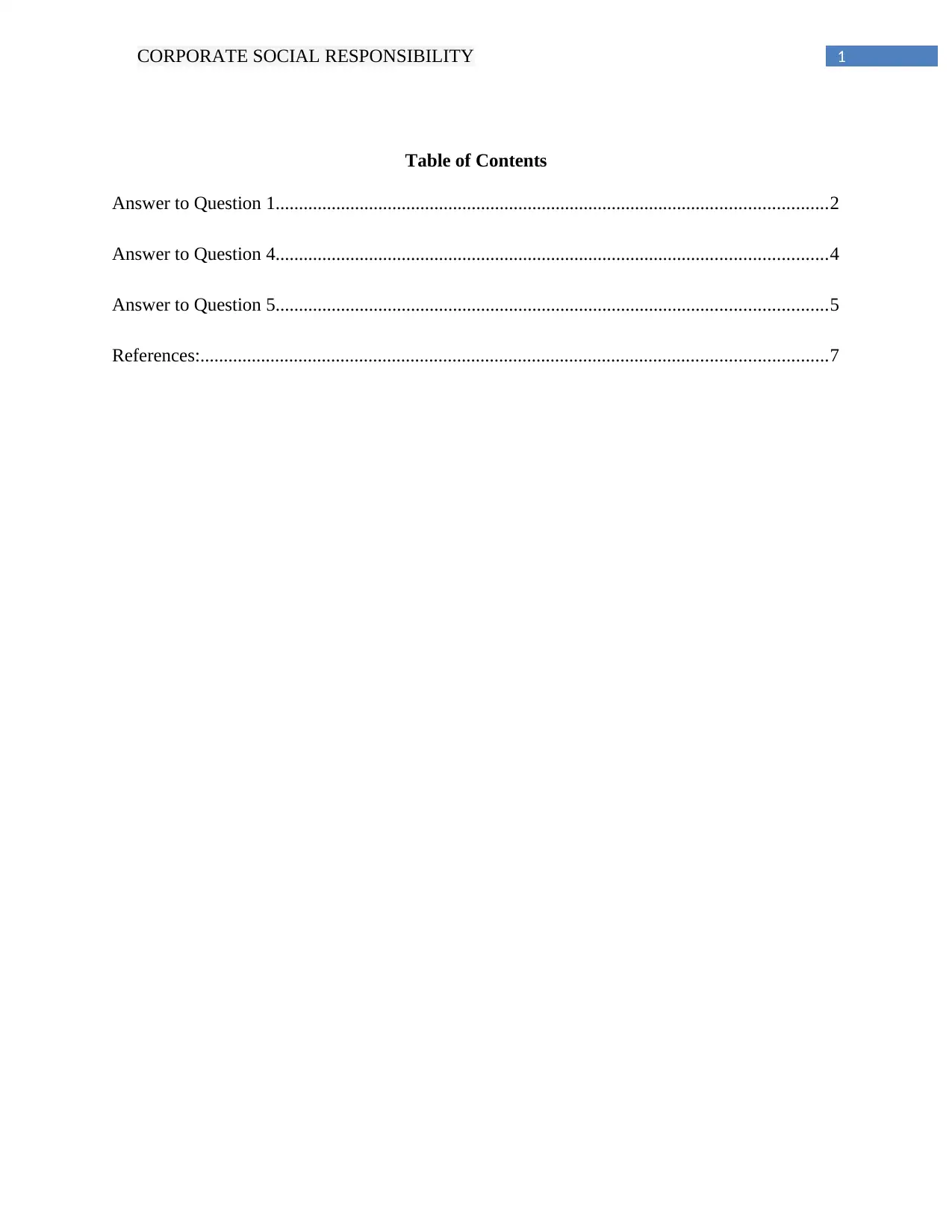
1CORPORATE SOCIAL RESPONSIBILITY
Table of Contents
Answer to Question 1......................................................................................................................2
Answer to Question 4......................................................................................................................4
Answer to Question 5......................................................................................................................5
References:......................................................................................................................................7
Table of Contents
Answer to Question 1......................................................................................................................2
Answer to Question 4......................................................................................................................4
Answer to Question 5......................................................................................................................5
References:......................................................................................................................................7
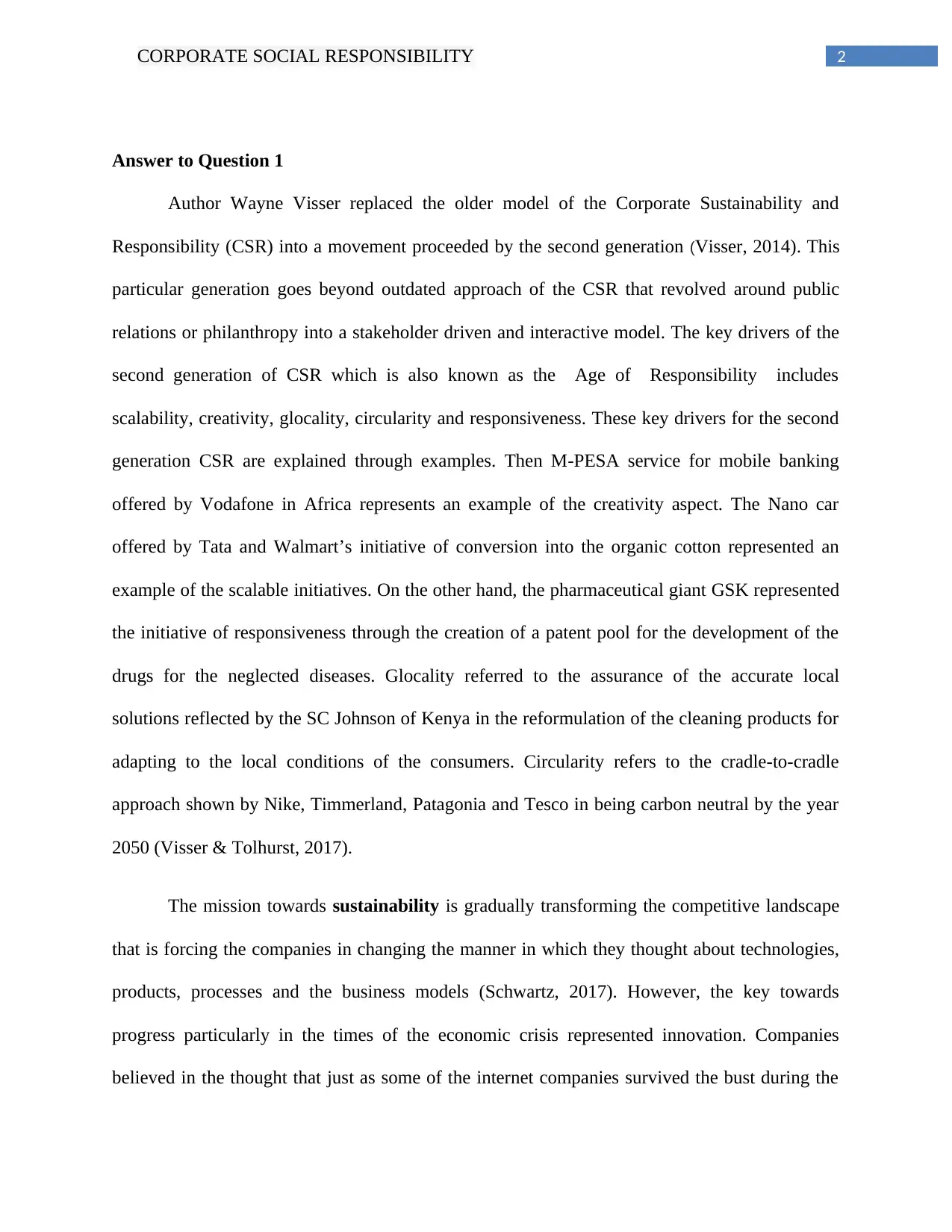
2CORPORATE SOCIAL RESPONSIBILITY
Answer to Question 1
Author Wayne Visser replaced the older model of the Corporate Sustainability and
Responsibility (CSR) into a movement proceeded by the second generation (Visser, 2014). This
particular generation goes beyond outdated approach of the CSR that revolved around public
relations or philanthropy into a stakeholder driven and interactive model. The key drivers of the
second generation of CSR which is also known as the Age of Responsibility includes
scalability, creativity, glocality, circularity and responsiveness. These key drivers for the second
generation CSR are explained through examples. Then M-PESA service for mobile banking
offered by Vodafone in Africa represents an example of the creativity aspect. The Nano car
offered by Tata and Walmart’s initiative of conversion into the organic cotton represented an
example of the scalable initiatives. On the other hand, the pharmaceutical giant GSK represented
the initiative of responsiveness through the creation of a patent pool for the development of the
drugs for the neglected diseases. Glocality referred to the assurance of the accurate local
solutions reflected by the SC Johnson of Kenya in the reformulation of the cleaning products for
adapting to the local conditions of the consumers. Circularity refers to the cradle-to-cradle
approach shown by Nike, Timmerland, Patagonia and Tesco in being carbon neutral by the year
2050 (Visser & Tolhurst, 2017).
The mission towards sustainability is gradually transforming the competitive landscape
that is forcing the companies in changing the manner in which they thought about technologies,
products, processes and the business models (Schwartz, 2017). However, the key towards
progress particularly in the times of the economic crisis represented innovation. Companies
believed in the thought that just as some of the internet companies survived the bust during the
Answer to Question 1
Author Wayne Visser replaced the older model of the Corporate Sustainability and
Responsibility (CSR) into a movement proceeded by the second generation (Visser, 2014). This
particular generation goes beyond outdated approach of the CSR that revolved around public
relations or philanthropy into a stakeholder driven and interactive model. The key drivers of the
second generation of CSR which is also known as the Age of Responsibility includes
scalability, creativity, glocality, circularity and responsiveness. These key drivers for the second
generation CSR are explained through examples. Then M-PESA service for mobile banking
offered by Vodafone in Africa represents an example of the creativity aspect. The Nano car
offered by Tata and Walmart’s initiative of conversion into the organic cotton represented an
example of the scalable initiatives. On the other hand, the pharmaceutical giant GSK represented
the initiative of responsiveness through the creation of a patent pool for the development of the
drugs for the neglected diseases. Glocality referred to the assurance of the accurate local
solutions reflected by the SC Johnson of Kenya in the reformulation of the cleaning products for
adapting to the local conditions of the consumers. Circularity refers to the cradle-to-cradle
approach shown by Nike, Timmerland, Patagonia and Tesco in being carbon neutral by the year
2050 (Visser & Tolhurst, 2017).
The mission towards sustainability is gradually transforming the competitive landscape
that is forcing the companies in changing the manner in which they thought about technologies,
products, processes and the business models (Schwartz, 2017). However, the key towards
progress particularly in the times of the economic crisis represented innovation. Companies
believed in the thought that just as some of the internet companies survived the bust during the
⊘ This is a preview!⊘
Do you want full access?
Subscribe today to unlock all pages.

Trusted by 1+ million students worldwide
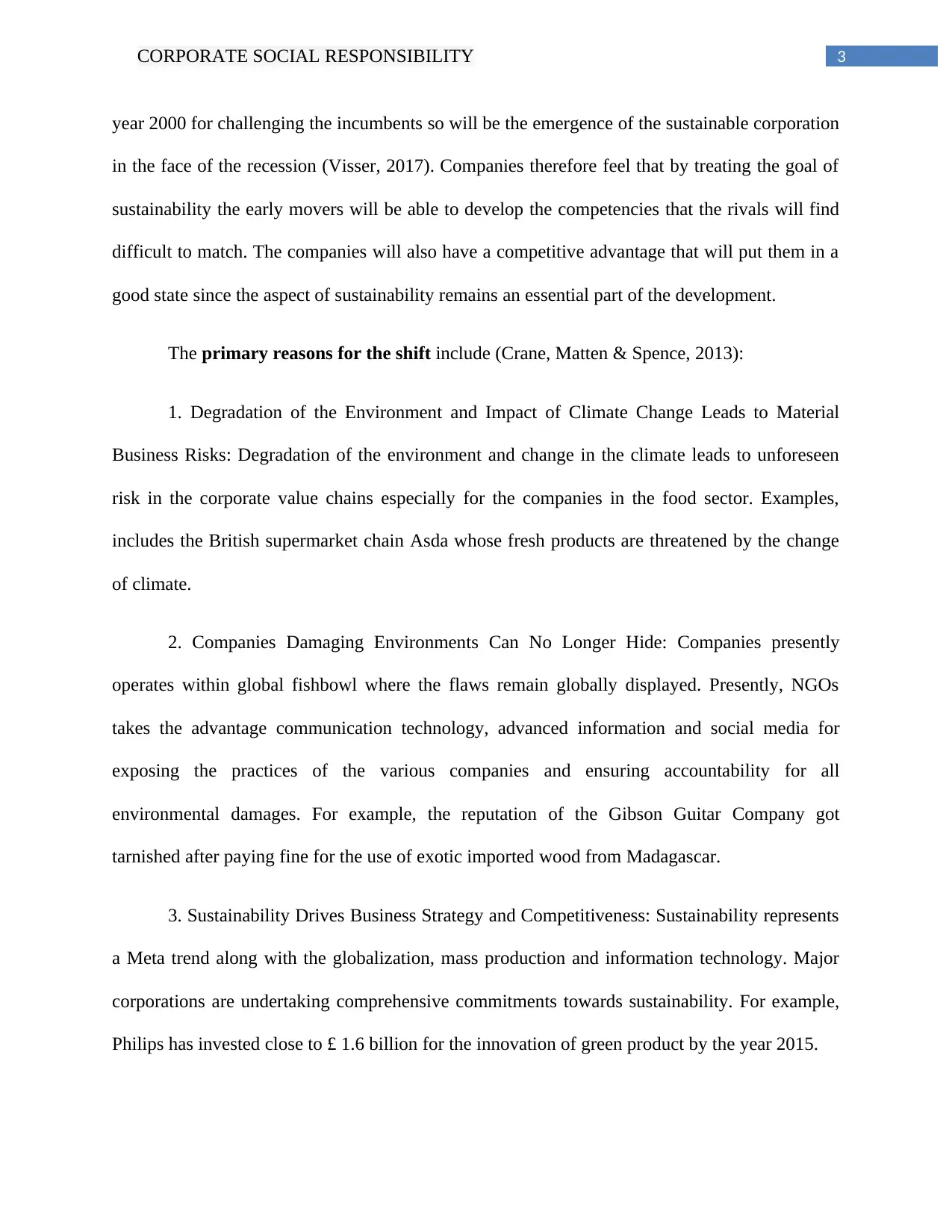
3CORPORATE SOCIAL RESPONSIBILITY
year 2000 for challenging the incumbents so will be the emergence of the sustainable corporation
in the face of the recession (Visser, 2017). Companies therefore feel that by treating the goal of
sustainability the early movers will be able to develop the competencies that the rivals will find
difficult to match. The companies will also have a competitive advantage that will put them in a
good state since the aspect of sustainability remains an essential part of the development.
The primary reasons for the shift include (Crane, Matten & Spence, 2013):
1. Degradation of the Environment and Impact of Climate Change Leads to Material
Business Risks: Degradation of the environment and change in the climate leads to unforeseen
risk in the corporate value chains especially for the companies in the food sector. Examples,
includes the British supermarket chain Asda whose fresh products are threatened by the change
of climate.
2. Companies Damaging Environments Can No Longer Hide: Companies presently
operates within global fishbowl where the flaws remain globally displayed. Presently, NGOs
takes the advantage communication technology, advanced information and social media for
exposing the practices of the various companies and ensuring accountability for all
environmental damages. For example, the reputation of the Gibson Guitar Company got
tarnished after paying fine for the use of exotic imported wood from Madagascar.
3. Sustainability Drives Business Strategy and Competitiveness: Sustainability represents
a Meta trend along with the globalization, mass production and information technology. Major
corporations are undertaking comprehensive commitments towards sustainability. For example,
Philips has invested close to £ 1.6 billion for the innovation of green product by the year 2015.
year 2000 for challenging the incumbents so will be the emergence of the sustainable corporation
in the face of the recession (Visser, 2017). Companies therefore feel that by treating the goal of
sustainability the early movers will be able to develop the competencies that the rivals will find
difficult to match. The companies will also have a competitive advantage that will put them in a
good state since the aspect of sustainability remains an essential part of the development.
The primary reasons for the shift include (Crane, Matten & Spence, 2013):
1. Degradation of the Environment and Impact of Climate Change Leads to Material
Business Risks: Degradation of the environment and change in the climate leads to unforeseen
risk in the corporate value chains especially for the companies in the food sector. Examples,
includes the British supermarket chain Asda whose fresh products are threatened by the change
of climate.
2. Companies Damaging Environments Can No Longer Hide: Companies presently
operates within global fishbowl where the flaws remain globally displayed. Presently, NGOs
takes the advantage communication technology, advanced information and social media for
exposing the practices of the various companies and ensuring accountability for all
environmental damages. For example, the reputation of the Gibson Guitar Company got
tarnished after paying fine for the use of exotic imported wood from Madagascar.
3. Sustainability Drives Business Strategy and Competitiveness: Sustainability represents
a Meta trend along with the globalization, mass production and information technology. Major
corporations are undertaking comprehensive commitments towards sustainability. For example,
Philips has invested close to £ 1.6 billion for the innovation of green product by the year 2015.
Paraphrase This Document
Need a fresh take? Get an instant paraphrase of this document with our AI Paraphraser
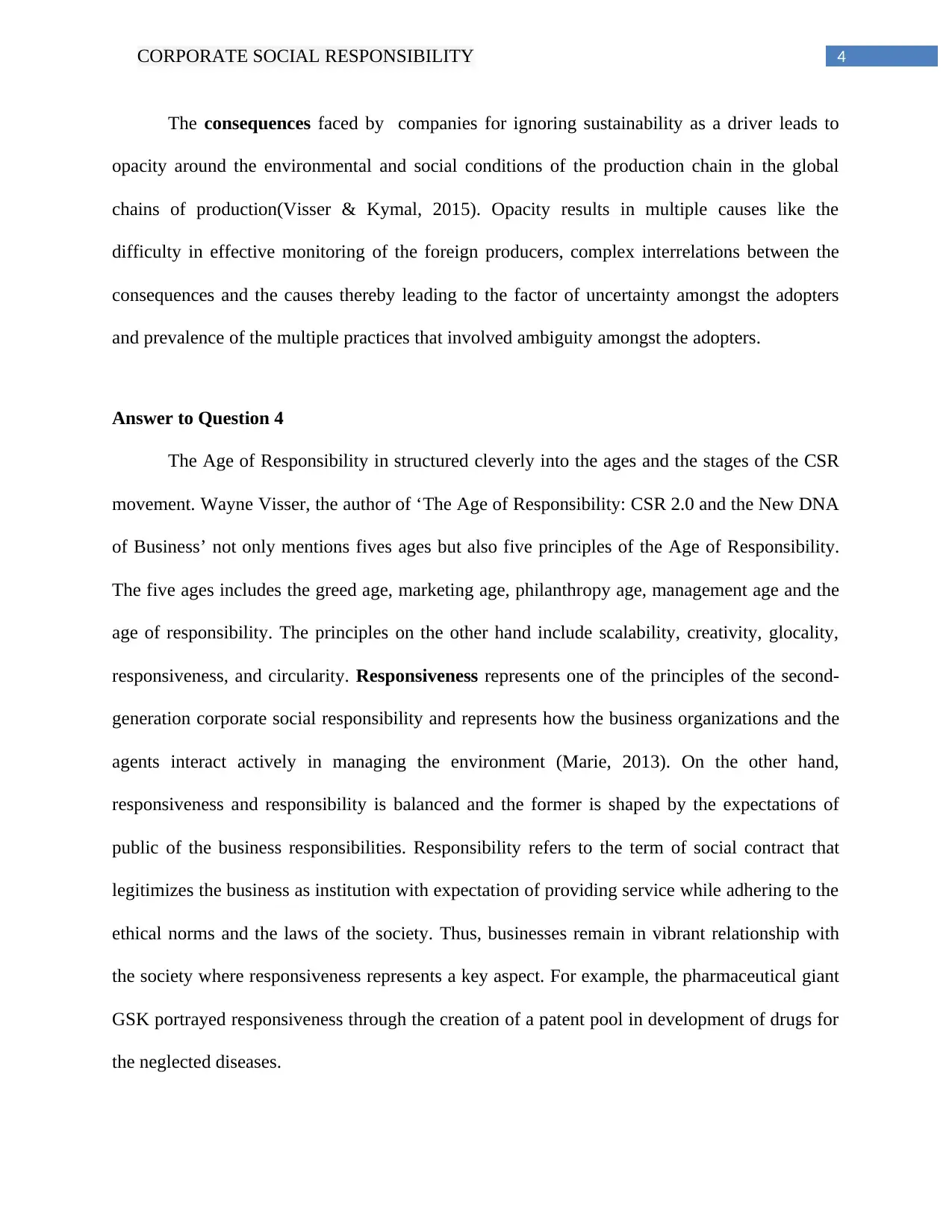
4CORPORATE SOCIAL RESPONSIBILITY
The consequences faced by companies for ignoring sustainability as a driver leads to
opacity around the environmental and social conditions of the production chain in the global
chains of production(Visser & Kymal, 2015). Opacity results in multiple causes like the
difficulty in effective monitoring of the foreign producers, complex interrelations between the
consequences and the causes thereby leading to the factor of uncertainty amongst the adopters
and prevalence of the multiple practices that involved ambiguity amongst the adopters.
Answer to Question 4
The Age of Responsibility in structured cleverly into the ages and the stages of the CSR
movement. Wayne Visser, the author of ‘The Age of Responsibility: CSR 2.0 and the New DNA
of Business’ not only mentions fives ages but also five principles of the Age of Responsibility.
The five ages includes the greed age, marketing age, philanthropy age, management age and the
age of responsibility. The principles on the other hand include scalability, creativity, glocality,
responsiveness, and circularity. Responsiveness represents one of the principles of the second-
generation corporate social responsibility and represents how the business organizations and the
agents interact actively in managing the environment (Marie, 2013). On the other hand,
responsiveness and responsibility is balanced and the former is shaped by the expectations of
public of the business responsibilities. Responsibility refers to the term of social contract that
legitimizes the business as institution with expectation of providing service while adhering to the
ethical norms and the laws of the society. Thus, businesses remain in vibrant relationship with
the society where responsiveness represents a key aspect. For example, the pharmaceutical giant
GSK portrayed responsiveness through the creation of a patent pool in development of drugs for
the neglected diseases.
The consequences faced by companies for ignoring sustainability as a driver leads to
opacity around the environmental and social conditions of the production chain in the global
chains of production(Visser & Kymal, 2015). Opacity results in multiple causes like the
difficulty in effective monitoring of the foreign producers, complex interrelations between the
consequences and the causes thereby leading to the factor of uncertainty amongst the adopters
and prevalence of the multiple practices that involved ambiguity amongst the adopters.
Answer to Question 4
The Age of Responsibility in structured cleverly into the ages and the stages of the CSR
movement. Wayne Visser, the author of ‘The Age of Responsibility: CSR 2.0 and the New DNA
of Business’ not only mentions fives ages but also five principles of the Age of Responsibility.
The five ages includes the greed age, marketing age, philanthropy age, management age and the
age of responsibility. The principles on the other hand include scalability, creativity, glocality,
responsiveness, and circularity. Responsiveness represents one of the principles of the second-
generation corporate social responsibility and represents how the business organizations and the
agents interact actively in managing the environment (Marie, 2013). On the other hand,
responsiveness and responsibility is balanced and the former is shaped by the expectations of
public of the business responsibilities. Responsibility refers to the term of social contract that
legitimizes the business as institution with expectation of providing service while adhering to the
ethical norms and the laws of the society. Thus, businesses remain in vibrant relationship with
the society where responsiveness represents a key aspect. For example, the pharmaceutical giant
GSK portrayed responsiveness through the creation of a patent pool in development of drugs for
the neglected diseases.
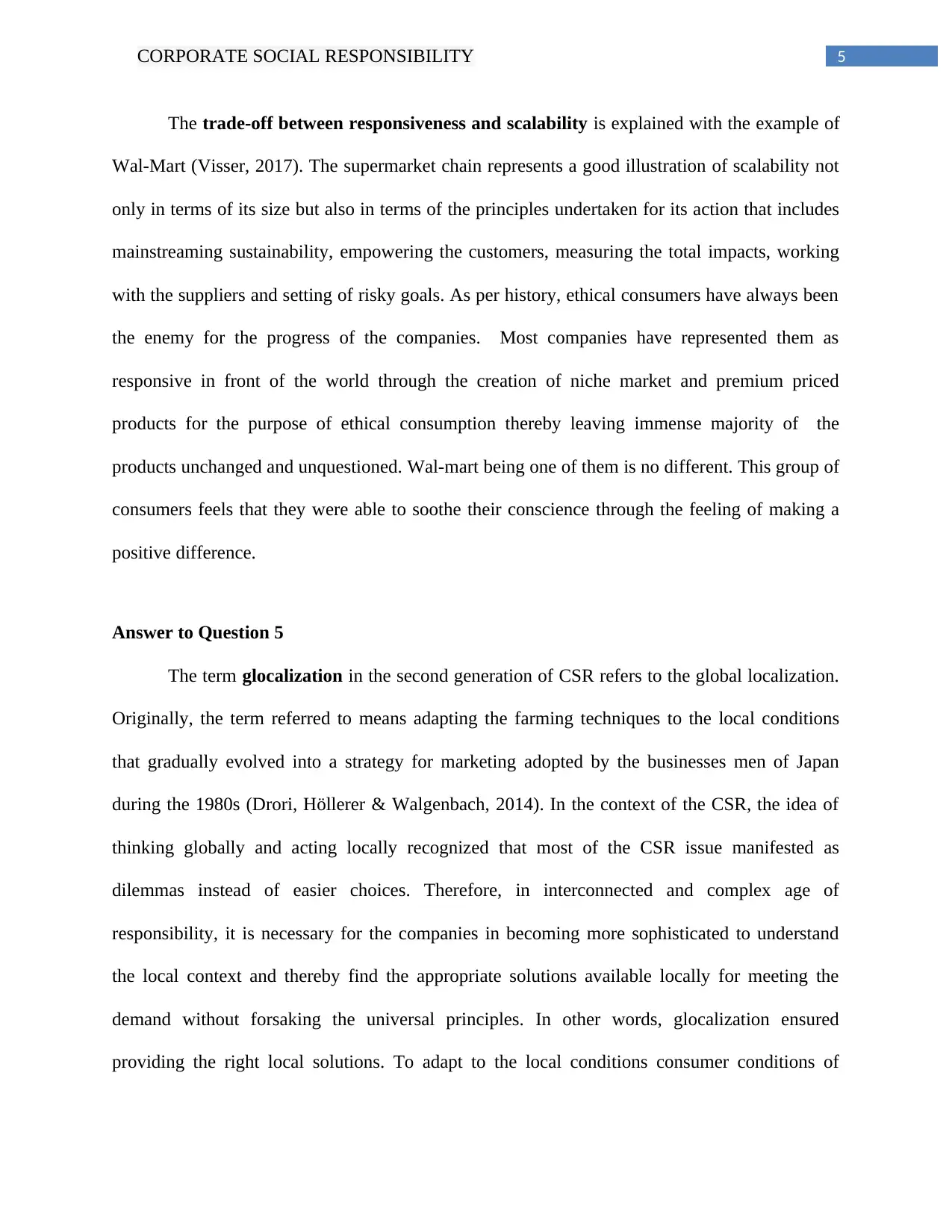
5CORPORATE SOCIAL RESPONSIBILITY
The trade-off between responsiveness and scalability is explained with the example of
Wal-Mart (Visser, 2017). The supermarket chain represents a good illustration of scalability not
only in terms of its size but also in terms of the principles undertaken for its action that includes
mainstreaming sustainability, empowering the customers, measuring the total impacts, working
with the suppliers and setting of risky goals. As per history, ethical consumers have always been
the enemy for the progress of the companies. Most companies have represented them as
responsive in front of the world through the creation of niche market and premium priced
products for the purpose of ethical consumption thereby leaving immense majority of the
products unchanged and unquestioned. Wal-mart being one of them is no different. This group of
consumers feels that they were able to soothe their conscience through the feeling of making a
positive difference.
Answer to Question 5
The term glocalization in the second generation of CSR refers to the global localization.
Originally, the term referred to means adapting the farming techniques to the local conditions
that gradually evolved into a strategy for marketing adopted by the businesses men of Japan
during the 1980s (Drori, Höllerer & Walgenbach, 2014). In the context of the CSR, the idea of
thinking globally and acting locally recognized that most of the CSR issue manifested as
dilemmas instead of easier choices. Therefore, in interconnected and complex age of
responsibility, it is necessary for the companies in becoming more sophisticated to understand
the local context and thereby find the appropriate solutions available locally for meeting the
demand without forsaking the universal principles. In other words, glocalization ensured
providing the right local solutions. To adapt to the local conditions consumer conditions of
The trade-off between responsiveness and scalability is explained with the example of
Wal-Mart (Visser, 2017). The supermarket chain represents a good illustration of scalability not
only in terms of its size but also in terms of the principles undertaken for its action that includes
mainstreaming sustainability, empowering the customers, measuring the total impacts, working
with the suppliers and setting of risky goals. As per history, ethical consumers have always been
the enemy for the progress of the companies. Most companies have represented them as
responsive in front of the world through the creation of niche market and premium priced
products for the purpose of ethical consumption thereby leaving immense majority of the
products unchanged and unquestioned. Wal-mart being one of them is no different. This group of
consumers feels that they were able to soothe their conscience through the feeling of making a
positive difference.
Answer to Question 5
The term glocalization in the second generation of CSR refers to the global localization.
Originally, the term referred to means adapting the farming techniques to the local conditions
that gradually evolved into a strategy for marketing adopted by the businesses men of Japan
during the 1980s (Drori, Höllerer & Walgenbach, 2014). In the context of the CSR, the idea of
thinking globally and acting locally recognized that most of the CSR issue manifested as
dilemmas instead of easier choices. Therefore, in interconnected and complex age of
responsibility, it is necessary for the companies in becoming more sophisticated to understand
the local context and thereby find the appropriate solutions available locally for meeting the
demand without forsaking the universal principles. In other words, glocalization ensured
providing the right local solutions. To adapt to the local conditions consumer conditions of
⊘ This is a preview!⊘
Do you want full access?
Subscribe today to unlock all pages.

Trusted by 1+ million students worldwide
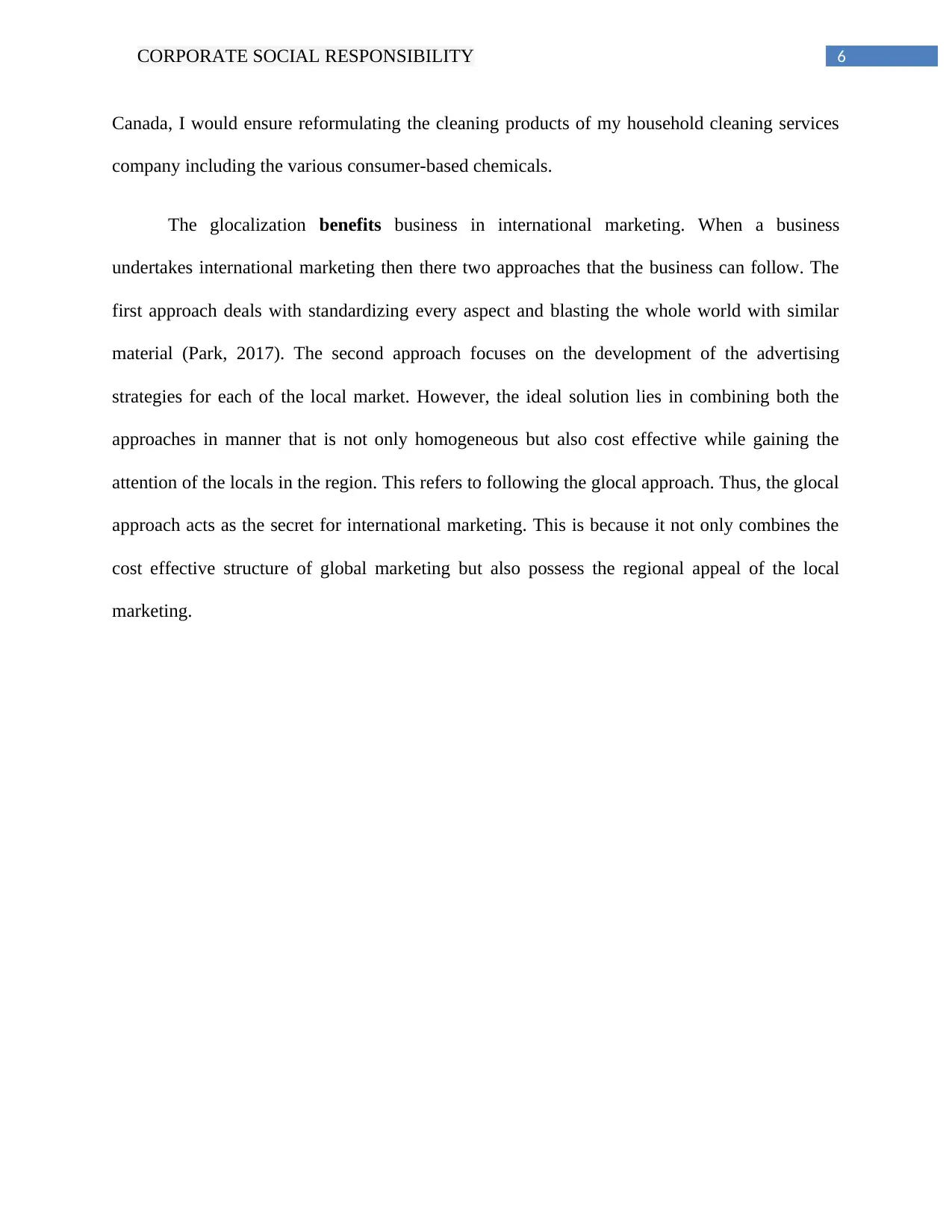
6CORPORATE SOCIAL RESPONSIBILITY
Canada, I would ensure reformulating the cleaning products of my household cleaning services
company including the various consumer-based chemicals.
The glocalization benefits business in international marketing. When a business
undertakes international marketing then there two approaches that the business can follow. The
first approach deals with standardizing every aspect and blasting the whole world with similar
material (Park, 2017). The second approach focuses on the development of the advertising
strategies for each of the local market. However, the ideal solution lies in combining both the
approaches in manner that is not only homogeneous but also cost effective while gaining the
attention of the locals in the region. This refers to following the glocal approach. Thus, the glocal
approach acts as the secret for international marketing. This is because it not only combines the
cost effective structure of global marketing but also possess the regional appeal of the local
marketing.
Canada, I would ensure reformulating the cleaning products of my household cleaning services
company including the various consumer-based chemicals.
The glocalization benefits business in international marketing. When a business
undertakes international marketing then there two approaches that the business can follow. The
first approach deals with standardizing every aspect and blasting the whole world with similar
material (Park, 2017). The second approach focuses on the development of the advertising
strategies for each of the local market. However, the ideal solution lies in combining both the
approaches in manner that is not only homogeneous but also cost effective while gaining the
attention of the locals in the region. This refers to following the glocal approach. Thus, the glocal
approach acts as the secret for international marketing. This is because it not only combines the
cost effective structure of global marketing but also possess the regional appeal of the local
marketing.
Paraphrase This Document
Need a fresh take? Get an instant paraphrase of this document with our AI Paraphraser
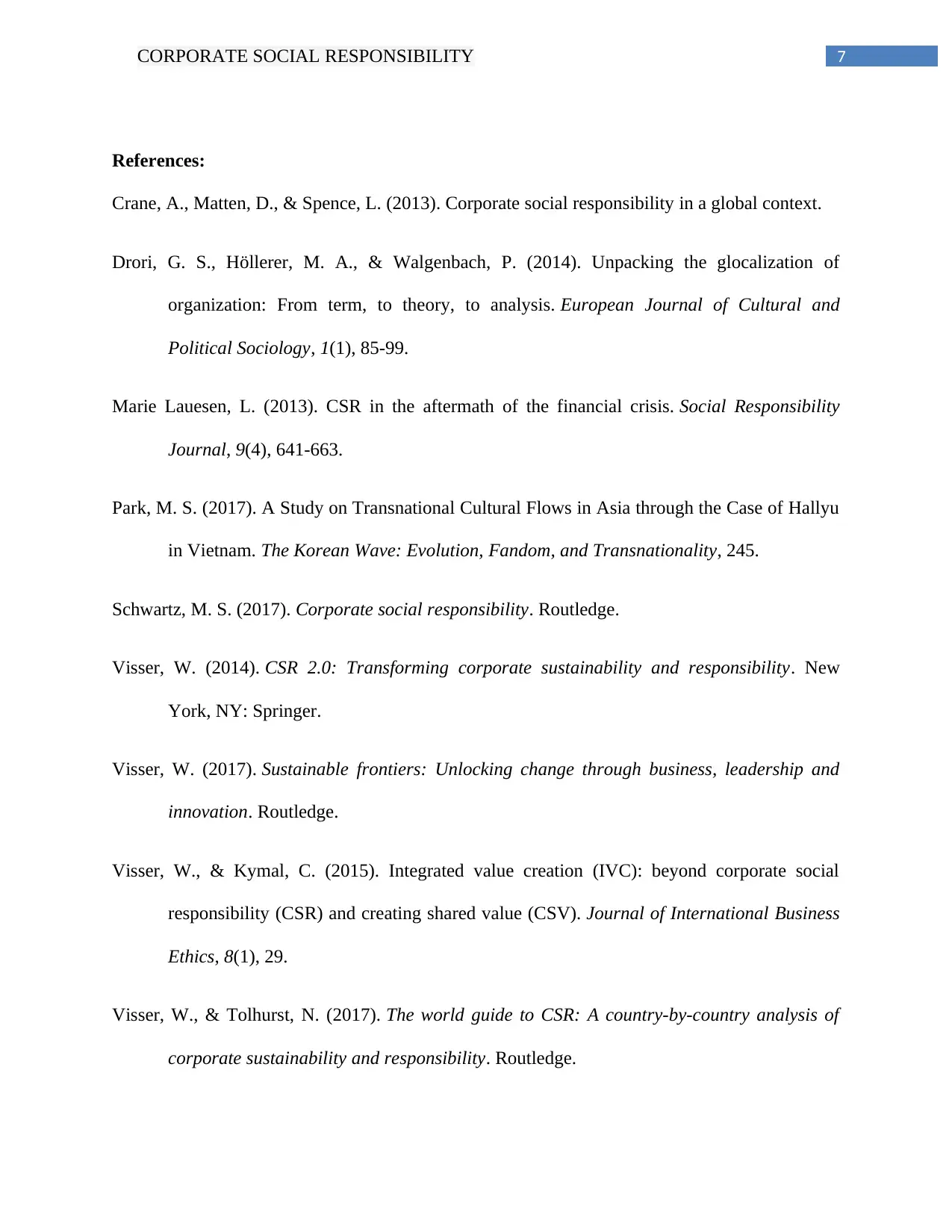
7CORPORATE SOCIAL RESPONSIBILITY
References:
Crane, A., Matten, D., & Spence, L. (2013). Corporate social responsibility in a global context.
Drori, G. S., Höllerer, M. A., & Walgenbach, P. (2014). Unpacking the glocalization of
organization: From term, to theory, to analysis. European Journal of Cultural and
Political Sociology, 1(1), 85-99.
Marie Lauesen, L. (2013). CSR in the aftermath of the financial crisis. Social Responsibility
Journal, 9(4), 641-663.
Park, M. S. (2017). A Study on Transnational Cultural Flows in Asia through the Case of Hallyu
in Vietnam. The Korean Wave: Evolution, Fandom, and Transnationality, 245.
Schwartz, M. S. (2017). Corporate social responsibility. Routledge.
Visser, W. (2014). CSR 2.0: Transforming corporate sustainability and responsibility. New
York, NY: Springer.
Visser, W. (2017). Sustainable frontiers: Unlocking change through business, leadership and
innovation. Routledge.
Visser, W., & Kymal, C. (2015). Integrated value creation (IVC): beyond corporate social
responsibility (CSR) and creating shared value (CSV). Journal of International Business
Ethics, 8(1), 29.
Visser, W., & Tolhurst, N. (2017). The world guide to CSR: A country-by-country analysis of
corporate sustainability and responsibility. Routledge.
References:
Crane, A., Matten, D., & Spence, L. (2013). Corporate social responsibility in a global context.
Drori, G. S., Höllerer, M. A., & Walgenbach, P. (2014). Unpacking the glocalization of
organization: From term, to theory, to analysis. European Journal of Cultural and
Political Sociology, 1(1), 85-99.
Marie Lauesen, L. (2013). CSR in the aftermath of the financial crisis. Social Responsibility
Journal, 9(4), 641-663.
Park, M. S. (2017). A Study on Transnational Cultural Flows in Asia through the Case of Hallyu
in Vietnam. The Korean Wave: Evolution, Fandom, and Transnationality, 245.
Schwartz, M. S. (2017). Corporate social responsibility. Routledge.
Visser, W. (2014). CSR 2.0: Transforming corporate sustainability and responsibility. New
York, NY: Springer.
Visser, W. (2017). Sustainable frontiers: Unlocking change through business, leadership and
innovation. Routledge.
Visser, W., & Kymal, C. (2015). Integrated value creation (IVC): beyond corporate social
responsibility (CSR) and creating shared value (CSV). Journal of International Business
Ethics, 8(1), 29.
Visser, W., & Tolhurst, N. (2017). The world guide to CSR: A country-by-country analysis of
corporate sustainability and responsibility. Routledge.
1 out of 8
Related Documents
Your All-in-One AI-Powered Toolkit for Academic Success.
+13062052269
info@desklib.com
Available 24*7 on WhatsApp / Email
![[object Object]](/_next/static/media/star-bottom.7253800d.svg)
Unlock your academic potential
Copyright © 2020–2025 A2Z Services. All Rights Reserved. Developed and managed by ZUCOL.




